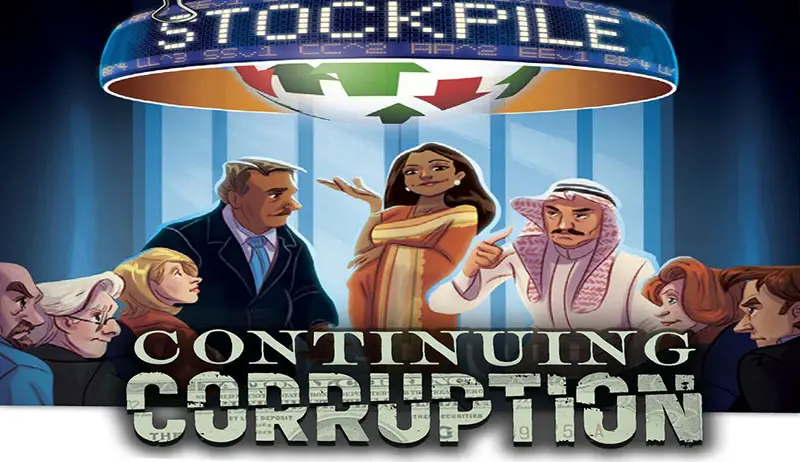
Stockpile: Continuing Corruption offers new ways to expand your crooked investment portfolio with four expansion modules: Investors, Bonds, Commodities & Taxes, and Forecast Dice.
These modules can be played separately, or together in any combination for more strategic game play.
Reference Cards contain a summary of all elements found in Stockpile: Continuing Corruption to help players remember the changes to the game round and scoring.
Components
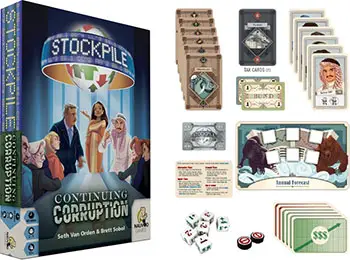
- 7 Tax Cards
- 18 Commodity Cards
- 40 Bond Cards
- 6 Investor Cards
- 10 Currency Cards
- 5 Reference Cards
- 1 Annual Forecast Board
- 2 Blocking Tokens
- 6 Forecast Dice
- 6 Shareholder Certificates
- 16 Forecast Cards
- Instructions
Investors
Investor Cards
New Investor Cards have been added to the game. Each investor has a unique ability detailed below.
Setup
Add the new Investor Cards to those of Stockpile. Shuffle all Investor Cards and deal two to each player. In a 2 player game, remember to take the adjusted starting amounts as shown in Figure 2.

Agile Ana
At the end of the round, you receive $1,000 for each unique company you own one or more shares in.
Note: You must reveal at least one of each of your different stocks to receive this benefit.
Clever Chanda

During your turn in the Action Phase, you may choose to discard one stock that you own in order to move one Stock Card from your Stock Portfolio to your Split Stock Portfolio.
Alternatively, you may move one stock from your Split Stock Portfolio to your regular Stock Portfolio to perform this action.
Note: You must reveal both stock cards affected by this action.
Cunning Carlos

During the Demand Phase, you must be outbid by at least two spaces on the Bidding Track.
Place a Blocking Token on the space ahead of you to indicate that it cannot be bid on. Use two Blocking Tokens for your Bidding Meeples in a 2 player game.
Example: If you bid $10K for a stockpile, then all other players must bid $20K or more to outbid you.

Daring Dangote
At the end of the round, you receive $1,000 per Commodity Card collected.
This includes Commodity Cards of the same type.
Note: This ability does not work for tax cards collected.

Lucrative Li
At the end of the round, you receive an additional $1,000 in interest for every two Bond Cards owned (rounded up).
Example: If you own three Bond Cards, then you receive $2K in additional interest payments at the end of the round.

Tactical Talal
At the end of the Selling Phase, you may sell again.
Note: You may sell any stock cards owned with this ability.
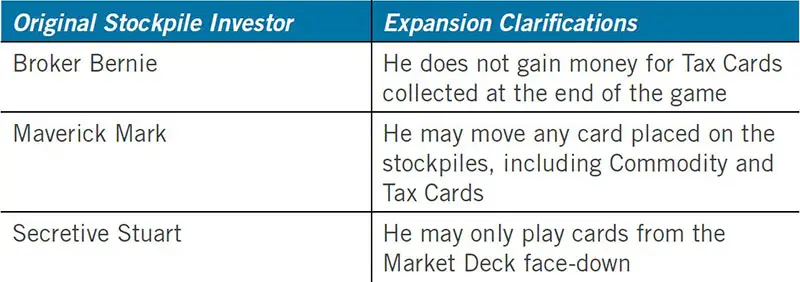 Figure 1 - Investor Clarifications |
 Figure 2 - Investor Starting Amounts for 2 Player Game |
Investor Bidding Variant
Instead of the standard way of choosing Investor Cards, players may choose to bid on Investor Cards before the game begins.
Deal two Investor Cards to each player. Each player picks one Investor Card and adds it to an empty Stockpile.
Beginning with the first player, players will bid on Investor Cards by using the same rules prescribed in the Demand Phase. Once all players have bid on a different stockpile, players collect their Investor Card and starting money.
The amount of money collected is equal to the starting value of each investor minus the amount bid for that Investor Card.
Note: You can't bid more than the starting value of an investor card.
2 Player Game
Same as above, except deal four investor cards and select two of them to place on the stockpiles. Remember to subtract the amount bid from the adjusted investor starting amounts.
Bonds
Bond Cards
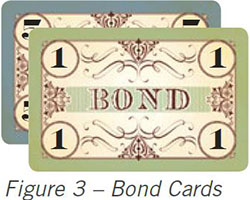
In Stockpile: Continuing Corruption, Bond Cards offer a risk-free way to invest your money and earn interest every round.
Purchase bonds early and generate big returns, but be careful not to overspend because you might miss out on valuable stockpiles.
Setup
Place the Bond Cards next to the Currency Cards.
Gameplay Changes
At the start of the round before Forecast Dice are rolled, players have the option to purchase up to 3 Bond Cards in turn order.
The price of Bond Cards is determined by the number of players, but the interest payments are always the same (see Figure 4).
Note: Bond cards may not be redeemed for money during the game. They are only valuable at the end.
End of the Round
Players receive $1,000 in interest per Bond Card owned from the bank.
End of the Game
Players redeem their Bond Cards for money from the bank equal to the full price paid for them during the game (see Figure 4).
Example: During the course of a 4 player game, I purchased a total of 7 Bond Cards. At the end of the game, I would exchange each of these Bond Cards for $5K, gaining a total of $35K (the same price I would have paid to obtain them).
 Figure 4 - Bond Card Prices and Interest Payments |
Commodities & Taxes
 Figure 5 - Commodity Cards and Tax Cards |
Commodity Cards
The Commodity Cards consist of six different types of commodities - gold, platinum, oil, natural gas, corn, and cattle. Players collect these Commodity Cards during the game to earn end-game bonuses.
Tax Cards
Tax Cards are also collected during the game, but Tax Cards cost players extra money at the end of the game.
Setup
The Commodity Cards are combined with the Tax Cards to form a new deck called the Commerce Deck. Place the Commerce Deck next to the Market Deck.
Gameplay Changes
Supply Phase
Once a player adds his/her cards from the Market Deck to the stockpiles, immediately draw 1 card from the Commerce Deck. After all players have completed this step, each player, in turn order, places their 1 card from the
Commerce Deck on any stockpile of their choice face-up.
In a 2 player game, players draw 2 cards from the Commerce Deck. In turn order, players add both their cards to the stockpiles, but a player cannot place both of his/her cards on the same stockpile.
Demand Phase
Players acquire stockpiles as normal, including any Commodity Cards placed on them. Commodity Cards are kept face-up next to each player's Player Board.
Note: The number and type of commodity and tax cards collected by each player is public information.
End of the Game
Commodity and Tax Cards are only valued at the end of the game. Commodities are scored based on the number of different types as shown in Figure 6. Commodities of the same type may also be scored.
Begin a new set with each duplicate Commodity Card and score the same as shown in Figure 6.
Example: I collected 6 Commodity Cards (2 cattle, 2 oil, 1 corn, and 1 gold). At the end of the game, I would receive a bonus of $32K ($24K for the 4 different commodities in my first set and $8K for the 2 different commodities in my second set).
Tax Cards are scored based on the total number of Tax Cards collected by the player as shown in Figure 7.
 Figure 6 - Commodity Cards End Game Bonus |
 Figure 7 - Tax Cards End Game Penalty |
Forecast Dice
Forecast Dice
The Forecast Dice are a new way to determine which Forecast Cards are paired with the Company Cards during a round. The Forecast Dice add variation and excitement to the game by changing the market forecast round-to-round.
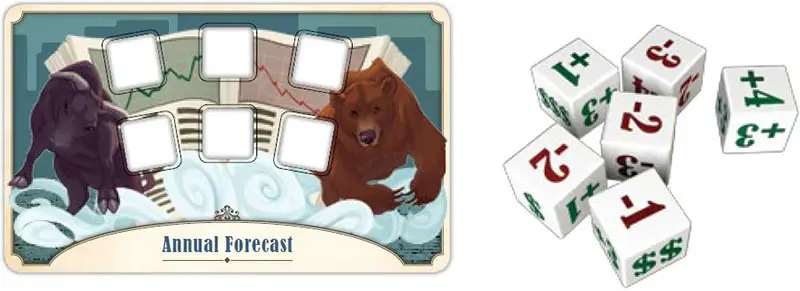 Figure 8 - Annual Forecast Board and Forecast Dice |
Setup
Add the new 16 Forecast Cards to those of the basic game and stack the Forecast Cards in piles next to the game board for convenience.
Place the Annual Forecast Board and Forecast Dice next to the game board.
Gameplay Changes
After players have chosen to purchase Bond Cards, the player with the First Player Token rolls all six Forecast Dice.
Place the Forecast Dice onto the Annual Forecast Board, so that everyone can see the values.
Pick up the Forecast Cards corresponding to the Forecast Dice values and shuffle them.
Proceed as normal by dealing 1 Company Card and 1 Forecast Card to each player face-down and placing the remaining cards face-up or face-down as prescribed in Stockpile.
End of the Round
Return the six Forecast Cards to the forecast piles.
Continue Reading

